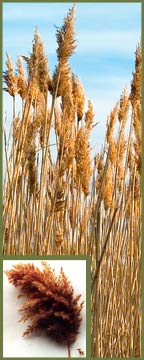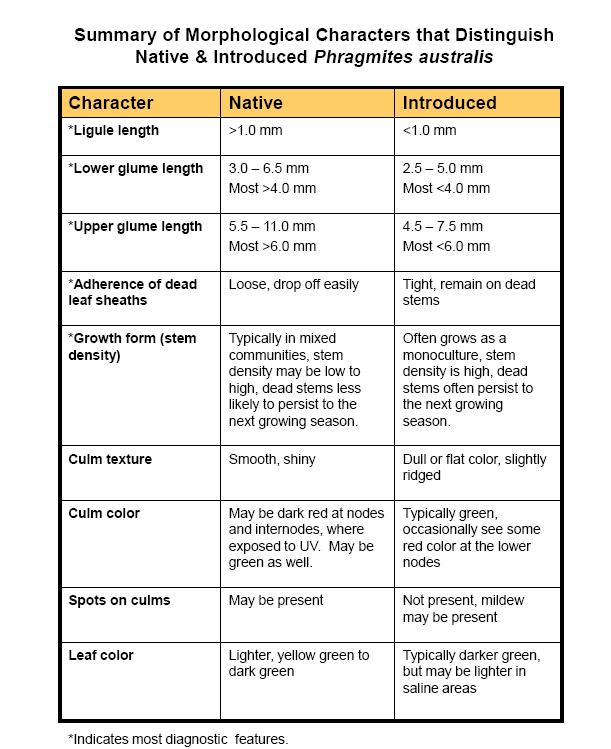Invasive Phragmites
 Phragmites australis spp. australis
Phragmites australis spp. australis
Dramatic increases in Phragmites have occurred in many areas of North America over the last 150 years and these increases are thought to be the result of invasive European biotypes.
In Manitoba from 2010 to 2012, this invasive has been found in several localized pathes in Winnipeg, Headingley and the capitol region. Â Several agencies are working to limit its spread.
Description - Common Reed, Invasive
General: Phragmites is a large perennial rhizomatous reed in the grass family.
Leaves: Leaves are stiff, flat, 20 to 50 cm long and about 1 to 4 cm wide, hairless and veined above while the underside is smooth and tapered to a long point at the end and are narrow towards the stem (lanceolate).
Stem: Stems are stiff, smooth, hollow, round, unbranched and become almost woody. Plants may grow as high as 6 meters tall.
Flowers: Flower heads appear on the stem tip in late June and are 10 to 40 cm long. Flowers are clustered along the branches of the plume and surrounded by silky white hairs.
Seed/Fruit: Large quantities of small brown seeds are produced.
Habitat
It is common in freshwater marshes, swamps, potholes, roadside ditches, retention ponds, riverbanks, brackish and alkaline wetlands as well as in some tropical wetlands. Usually found in the marsh-upland interface.
Dispersal
Seeds are dispersed over the fall and winter months mostly via wind, water and perhaps by birds. Once established, further spread is primarily through vegetative reproduction. Rhizomes and rhizome fragments are dispersed by water currents, animals and construction equipment such as road maintenance equipment.
Impacts
Dense Phragmites stands eliminate habitat for valued wildlife species altering ecological function of wetlands. Mixed wetland plant communities are replaced by near monocultures of Phragmites changing ecosystem processes and having detrimental impacts on native wildlife.
Control Methods
The most effective control measures are cutting, draining, herbicides and combinations of these controls. Mowing, disking and pulling have all been used, however, these methods are discouraged. Mowing does not address rhizomes and disking can result in an increase in populations by creating additional pieces of rhizomes.
Differences from Native Phragmites
It can be difficult to determine if a plant of Phragmites is the native or invasive species of Phragmites. Here's a chart to help:

Chart by: Jil Swearingen and Kristin Saltonstall, in Phragmites Field Guide
Resources
Invasive Phragmites ISCM Fact Sheet
2011 Rural Municipality Distribution Map
2010 Rural Municipality Distribution Map
Â
Back to Aquatic Invasive Species List
Back to Terrestrial Invasive Species List
Â
© Copyright 2004-2024 - CMS Made Simple
This site is powered by CMS Made Simple version 1.4.1


